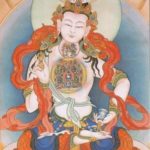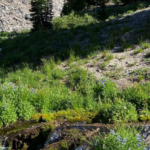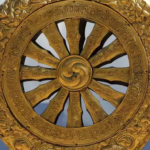Dear Friends,
I still remember when the pandemic was first announced – our first meeting when our team was faced with so many decisions. We eventually scrapped the year’s calendar we had planned and re-imagined our activities one month at a time until we faced that the whole year would be online. Instead of flying to California to stay at Dakini Mountain for our summer retreats, I remained in Virginia. That was the beginning of letting go of everything we had imagined for the year.
When the pandemic first hit we had just finished a year-long study on the Buddhist philosophy of impermanence. And suddenly, impermanence seemed so obvious to everyone. The stories of losses started coming in from the community. The loss of social life to the lock downs, the job losses and the loss of structure and security. Sadly, the loss of loved ones too. I grieve with you for the family members and friends we lost this year. May they rest in peace and find freedom.
The biggest challenge our team faced early on in the pandemic was how to go forward with our consecration of Dakini Mountain. It was a day we had been waiting for and looking forward to for so long. We knew that auspicious energy would be needed for Dakini Mountain since it became clear that we would have to cancel our entire retreat season. In the end we re-imagined the consecration through a weekend long online event – a Vajrayogini retreat taught by myself and Drupon Rinchen Dorjee Rinpoche. I taught the Vajrayogini Chod cycle with Rinpoche giving the empowerment into Vajrayogini generation stage. The weekend culminated with the consecration at Dakini Mountain. Here is a photo of that beautiful event.
Throughout the summer, in place of the retreats we offered three series featuring 12 guest teachers. The first series was In the Presence of Dying, which featured talks on Buddhist views and practices for death and dying. This was followed by a daylong teaching on instructions for dying from Dzogchen. I also taught the Zhitro practice, which is the Tibetan funerary rite to guide the deceased ones through the post-death state. If you missed the teaching on Dying but wish to attend, I will be teaching this for Zen Mountain Monastery in New York via an online program – click here to find out more. And this winter I will give an advanced class on Dying, Death & Living in the Bardo.
Can Vajrayana be taught online?
We also had, for the first time, our Dzogchen retreat online. This is usually our big annual retreat in person together, and would have been at Dakini Mountain, but we brought it online. It was a stunning experience for me actually. The students who were committed and focused on the retreat, dedicating their time in a focused way and showing up to every practice had a deep and profound experience. It was so moving. Before the pandemic, the thought of doing Dzogchen online was of course out of the question. There are traditional reasons for this which orbit around what constitutes transmission, the essential ingredient in Vajrayana practice. But this year the opinions about this shifted and opened up in the Vajrayana communities. I saw the intense dedication of the community who practiced and studied through so many obstacles. Through job losses, wildfires, illness, loss of loved ones and intense uncertainty, we all kept practicing. Seeing this, I felt the highest integrity would be to support the students who wanted to keep their commitment to practice through this crisis. So we did the annual Dzogchen retreat online and it was a beautiful experience. It was touching to see the home shrines of the participants and to feel our connection to one another.
Can Buddhists be Angry?
In September, we had a series focused on the “Bodhisattva in Troubled Times,” to address this issue. The point of this program for me was to reflect with our guests on the complex relationship between anger and our bodhichitta- the altruistic enlightened intent. Some people believe the stereotype that Buddhism is all about suppressing anger, and there are forms of Buddhism that have anti-anger rhetoric. Meanwhile, others criticize Tibetan Buddhist tantra for its radical engagements with wrath, anger, power and at times the rhetoric of domination and control. For my community, the role of anger in terms of moral outrage was very clear in the wake of racial violence in the U.S. The anger and moral outrage rallied awareness and momentum for change.
So how does this all interface with the bodhisattva ideal? What is the role of anger if we seek to live compassionate altruistic lives? In Buddhist tantra we think of anger in terms of the “Vajra” family in the five Buddha families, an energy that can arise as clarity or it may trigger a cascade of aggressive neurosis. It is an energy that requires great care, meticulous presence, lest we lose our altruistic enlightened intent. I suggested that we can realize that anger may be natural, acceptable, and have its place in healing and social change, while at the same time recognizing that we must be very careful with it. Like a sharp weapon, we carry it mindfully realizing that we could easily hurt ourselves and others. We recognize that it is, as one of the sangha members so aptly put it, a bardo. In other words, it is an impermanent state, one that has to be met with care and wisdom.
In October, we turned to the topic of Buddhist Sexuality reflecting on everything from non-celibate practice to sexual abuse and responses to sexual abuse in Buddhist communities. This had been preceded by study of texts about sexuality in Buddhist tantra that we conducted during the Vajrayana training. But the ultimate context of this was the #metoo movement in Buddhism. We covered so much but there is so much more to cover and I hope we will do that in the times to come. I realized through this program, how much emotional labor it takes to talk about these issues, especially because my scholarly research is also touching on this subject. But I had this sense that the emotional labor is worthwhile, for the awareness and potential for change it produces. For me, the motivation is that Buddhist community would be a safe place for women and for all vulnerable people since abuse harms every kind of person.
We also had our annual Vajra Sangha retreat online. This is an event where usually the Vajra Sangha members all come to stay with me at Khandro Ling and is one of the most memorable events of the year. But this year, with the pandemic and everyone’s safety in mind we canceled that and instead had a one-day Vajra Sangha day of practice, teaching and reflecting. Although we met online this time, there was still some sense of the special energy we have together. Actually I was startled by that, how we could cultivate a sense of connection and a palpable sense of the sacred space we hold together – even though it was through an online medium.
Season of Practice
As we turned towards the winter, despite the pandemic we have continued in our annual tradition of a “season of practice” from November to February. This is a period from November until Losar, the Tibetan New Year (this year on February 12). Thanks to our project, the Buddhist Studies Institute, this season has been one of support for practice on multiple fronts.
100 Days of Practice Daily Meditation
For the first time we decided to create an online daily free meditation class for the entire practice season. Usually we all brave this period alone and it has been beautiful to see this period led by our Meditation Instructor Training Alumni as well as Group Leaders.
This year the 100 days of practice has been led by Janak, Tsal’gyur, Fa Jun, Zat, Dedzin, Norbu, Kundini, Namkhai, Tashi, Detsal, Kalsang, Darius, Ngawang and Sonam. It is continuing every day at 12pm San Francisco time (PST), 3pm New York (EST), and 8pm London (GMT).
It has featured the refuge, bodhichitta and bodhi vows followed by twenty-four minutes of Zhine, Calm Abiding meditation. It is twenty-four minutes because that is the length of our daily practice cycle – one minute for every hour of the day. This is followed by a short reading of one of the five precepts and then followed by group conversation. Congratulations to everyone who has been attending. I imagine that these last two weeks are the hardest to maintain as we headed deep into winter and the holidays. But this is how discipline is forged, one day at a time, regardless of obstacles and distractions.
Discipline and structure keep us in tune with life’s meaning.
Ngondro – Iron Mice Sangha
In 2020, we also started a year-long Ngondro training to support a group to finish ngondro. It began in November in this year of the Iron Mouse. We have been wanting to do an online ngondro program for a long time and now we finally have set it in motion. Ngondro is the foundational training for Vajrayana. But to accomplish Ngondro requires determination, it is a practice which is traditionally repeated 100,000 per practice totaling 400,000 – 500,000 repetitions per practice. It is hardcore training of the body and mind!! But it is more than just repetition – at best it is a sense of lingering with great attention in the poetry, prayers, songs and postures of Tibetan Buddhist meditation. Therefore, it is beautiful for those who can allow it to be.
We have been doing the Longchen Nyingthig Ngondro, which means the preliminaries of the Heart of the Vast Expanse. As you are reading this now, someone is doing Ngondro. We have a whole group performing it daily so that the whole group will be ready for the second module in February.
You can read more about it here and you can still join.
If you are in the Ngondro program and have fallen behind, you can still catch up before the next module by doing 185 repetitions a day starting January 1st.
For those of you doing Ngondro now, we added additional Ngondro videos to watch at home. You can watch them here.
Meditation Instructor Training
We are also in the midst of Meditation Instructor training attended by students from around the world. It started in October and goes through February. This is a 150-hour training for experienced meditators and teachers to integrate Buddhism’s most powerful supports into their meditation instruction – from ethics to empathy, Trauma-informed practice to Buddhist philosophy, it provides this firm support for teachers to develop skills to teach meditation at its highest level. For some of our instructors in training, they are in quarantine, others live in countries where there is no coronavirus crisis right now. Whatever their circumstances they are all coming together diligently to practice, study and develop their leadership skills. You can read more about it here. Or if you’d like to meet the new instructors, they will be leading MIT as student-teachers for the New Year Meditation Marathon (the last forty days of our 100-day period).
Dakini Mountain
Dakini Mountain has also made it through this year despite California having its worst fire season ever – 4.1 million acres burned. Dakini Mountain is our new retreat land and it is in Northern California in the Tahoe National Forest, the native land of the Washoe and Nisenan tribes. Although we canceled our in-person retreats, the land has been the site of intense focus and time-consuming efforts on the part of our team (and especially my right-hand-woman, Aruna). The wildfires in California darkened the skies but did not reach this land, and we were blessed that Dakini Mountain did remain safe. My heart goes out to everyone who lost their homes or who were adversely affected by the fires. So many of our sangha members had to temporarily relocate until the fires calmed down. While the fires were blazing, a water crisis touched Dakini Mountain. This happened more than once in 2020 as we discovered broken pipes and a troubled irrigation system that needed a lot of work. We were able to start a fire clearance to protect the land and started repairs on the water system and if we meet our fundraising goal of $20,000 by January 1st, we will cover the cost of these repairs and stage 1 fire clearance – Click Here to Donate. The land itself has been changing dramatically through the seasons. Here is a photo from last winter of Dakini Mountain in the snow to give you a sense of what happens there. Rigdzin pond becomes ice and the land gets blanketed by snow which sparkles like diamonds.
Yogic Medicine Institute
Even though our retreats were closed, we did conduct some small versions of the Panchakarma retreats in personalized form. This is the Ayurvedic detoxification, cleansing and rejuvenation program led by the Yogic Medicine Institute. It is an intensive process and three to five of our sangha staff these retreats. They work incredibly hard and the results are stunning. The people who come for PK at Dakini Mountain leave looking ten years younger. I am so proud that we were able to offer this support for healing and health during the pandemic when it is so important. Satya and Aruna have been coordinating these events with great skill and care.
The 21 Taras
Our final event of the year was the 21 Taras transmission with Drupon Rinchen Dorjee Rinpoche. May this be the beginning of many more occasions where we sing this beautiful prayer together. This was also my birthday celebration – thank you to everyone who sent notes and messages, who donated and supported this year and this event. I am touched by your care and feel grateful for our beautiful connections.
“Homage Tara, swift heroic, eyes like lightning instantaneous,
Sprung from opening stamens of the lord of three world’s tear-born lotus.
Homage she whose face combines a hundred autumn moons at fullest…”
If you would like to listen to us singing it you can listen here.
Through all this practice and activity that has taken place we have had a dedicated team of volunteers, leaders and staff. I feel grateful and honored to be working with a community of such kindness and collaboration. I know that the programs have brought comfort, inspiration and stability to so many and that is only possible thanks to the generosity of donors, volunteers, leaders and staff.
Thank you especially to everyone who donated to the Dakini Mountain Emergency Fund for my birthday. Thank you for your notes, letters and well-wishes, it touches me deeply. I am honored to be connected to such a lovely community.
Also, thank you to our Leadership – Aruna, Satya, Janak, Tsal’gyur, Dedzin and Kundini for helping make our programs possible. Your service is greatly appreciated.
It is the end of the year but still so much uncertainty lies ahead. In the U.S. where the coronavirus is raging and many of us are on lock down or curfews, there is this looming sense of the unknown. But one thing we learned this year remains with us – the sense of interdependence, the urgent need to relieve suffering. The importance of continuously training our body and mind.
Whatever comes, this too is what we have been training for. To face whatever comes with bodhichitta, to meet life wakefully and bear what is as best we can.
Yours always,





